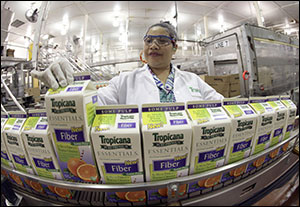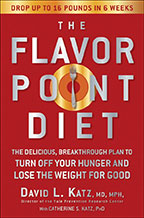
As dairy marketers, it is important to know what tricks the competition has in store. From this sneak peek, I am sure you will agree that 2006 is going to be an interesting year in the health and wellness category.
For example, on a recent single-digit temperature day in Chicago, I was inundated with press releases announcing many health and wellness oriented products. Bradenton, Fla.-based Tropicana Products Inc., a division of PepsiCo Inc., Purchase, N.Y., says that the company is helping people meet their daily fiber requirements with the introduction of the first national orange juice with fiber.

ConAgra Foods, Omaha, Neb., announced that it has come up with a significant breakthrough in more nutritious snacking. Starting in February 2006, ConAgra's popular Orville Redenbacher's® and ACT II® microwave brands will not only be made with popcorn that is 100% whole grain, but will also have 0g of trans fatty acids.
Global Beverage Solutions, Tulsa, Okla., under its majority-owned subsidiary Rudy's Beverage Inc., will debut a new line of beverage drinks in January. The drinks will enter the market through the names Rudy Revolution™ and Rudy Flying Colors™.
Rudy Revolution will be classified in the sports drink arena and directly compete with Gatorade® and PowerAde®. However, while these two competitors are surprisingly similar in composition, Rudy Revolution differs with superior hydrating qualities and increased nutritional values, with just half of the sugar content, according to the company.
Rudy Flying Colors is a kids' drink that will come in several different flavors, i.e. Blue Raspberry, Strawberry Punch, Orange Lemon Lime and Grapealicious. With brightly colored labels canvassing the bottles, these drinks are oriented to the children's drink market. The formulation is based on an advanced sweetener endorsed by the Pediatric Dental Association because of its ability to reduce dental decay, according to the company. (The company is remaining vague on the sweetener until the product hits the marketplace.)

I must share more. The diet works on three guiding principles. First, do not mix sweet and salty foods at the same meal. Supposedly the combination of these two tastes over stimulates the brain’s appetite center, causing one to overeat. If you separate sweet and salty foods throughout the day, one eats less, makes healthier choices and loses weight.
Second, the authors say that the more on the list, the more on your belly. What this means is that the longer is a food’s ingredient list, the more hidden flavors it has, and the more it will stimulate the appetite. Simple is better.
And third, eat a bit of the same food with every meal. This is supposed to make the taste buds fill up faster, speeding up one to reach “the flavor point.” (Let’s hope milk or some dairy food becomes that repetitive food of choice for folks who decide to try this diet.)
Philadelphia-based ARAMARK, one of North America’s largest food and vending operators, even got into the health and wellness trend this year. The company issued the following health and nutrition tips to help Americans stick to their resolutions.
- Drink more water. Although most people understand the benefits of water, most still do not drink enough of it during the day. Water has zero calories, zero caffeine, zero carbs and is the perfect beverage to curb the appetite and reduce hunger cravings. (It’s hard to compete here.)
- Snack wisely. Many people find that eating a couple of small snacks throughout the day helps them to make healthier choices at meal time. At the office, many healthy snacks can be found in vending machines such as low fat granola bars, pretzels, trail mix and baked chips. (Sure wish they would have mentioned dairy.)
- Drink your coffee. Recent studies indicate that drinking coffee in moderation can be good for your health. For example, drinking four or more cups of coffee a day may slightly lower your risk of developing high blood pressure and may also contribute to healthier blood sugar levels. Do the calories in coffee have you worried? Use nonfat milk or cream in your coffee, limit your use of sugar or switch to alternative sweeteners. (Thanks for the dairy mention, but four or more cups do not sound like moderation . . . unless of course you are a coffee vendor!)
- Try tea. Tea is a no-calorie, no-fat beverage and a natural source of antioxidants that help the body fight harmful free radicals, which may lead to cancer and heart disease. Drinking tea has also been shown to improve digestion, strengthen the immune system and boost metabolism. Try it hot with nonfat milk or honey, or chilled with lemon and artificial sweetener. (Go nonfat milk!)
So, what’s in the stars for 2006 in foodservice? Well, if you can read, you will now know what you are consuming when you eat at McDonald’s. Oak Brook, Ill.-based McDonald’s Corp., plans to provide nutrition information on the individual packages of each and every item that it sells at its restaurants.
For the overall food industry, Mintel International’s Lynn Dornblaser, director of the custom solutions group based in Chicago, shared with attendees of the recent Worldwide Food Expo what her projections were for the next five years. For starters, consumers are taking a more holistic approach in life and are caring for their body on the inside and out. Consumers are starting to get that it is all about balance, which includes eating the right things in the right quantities, and even indulging in small ways every now and then. Portion control and mini sizes are in style.
Second, consumers will continue to turn to foods and their constituents to assist in disease prevention. Obesity and osteoporosis are already there; however, an increasing number of foods that will be introduced in the next five years will address heart disease and diabetes prevention, with the latter particularly important in products for children. Keeping a close eye on kids, trend number-three is that there will be a noteworthy increase in the number of products formulated just for kids, foods and beverages that provide the balanced nutrition children require for proper growth and development. This includes introducing kids to a holistic approach to food choices, a tactic that promotes physical well being along with mental health.
The fourth trend is to look East to Europe (trends include probiotics and food that are “free” of undesirables) and the fifth trend is to look West to Asia, where black foods (made with black soybeans, which possess unique functionalities) and isolated amino acid-fortified foods are becoming increasingly popular.
The sixth trend is that Americans are celebrating age. It is O.K. to get old! However, this demographic, which is very willing to dip into their pockets for foods and beverages that slow down the aging process, wants products formulated to meet their specific “aging” needs. Of course, this must be communicated discreetly.
The next two trends are not new. The important fact to remember is that number-seven—a return to simplicity/home-style—and number-eight—the desire for instant gratification—are not going away. The latter builds on the former, with consumers wanting their meatloaf, but ready in the microwave in three minutes. And even better, in a hand-held form.
Wrapping things up, Dornblaser says that trend number-nine—increased awareness in cause marketing and Fair Trade—comes from an increased understanding of global issues. This leads to number-10: Multiculturalism. Though New Orleans is a local culture, there has been an increased interest in Cajun as a result of the devastation caused by Hurricane Rita. Indeed, domestic or international, consumers are rediscovering traditional cuisine, or “local ethnic,” as Dornblaser explains.
What does all this mean for the dairy industry? The answer lies with each and every one of you and how determined your company is to make dairy attractive and competitive in a world of too much information and too many messages.
However, with that said, I leave you with this comment made by Neville Isdell, chairman and CEO of Coca-Cola Co., Atlanta.
“Without innovation, there can be no growth,” he says. “For more than half its history, Coca-Cola sold exactly one product in exactly one package. Today, the company markets nearly 400 brands in more than 200 countries, in an extensive range of package materials, shapes and sizes. That probably sounds like an enormous number, but to anyone who works with consumers on a day-to-day basis, the expansion of preferences, the proliferation of options, the relentless demand for choice, is a basic fact of life. Coca-Cola does not offer 400 brands because retailers have millions of kilometers of shelf space that otherwise would remain empty. And retailers don’t offer all that shelf space to accommodate our thousands of SKUs (stock-keeping units). No. We—all of us—exist to create value.”
Happy New Year everyone! Commit to add value to dairy foods in 2006.